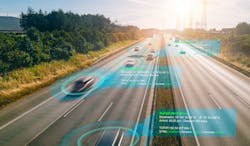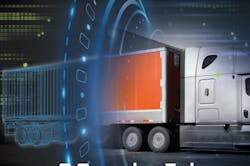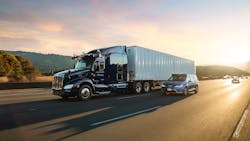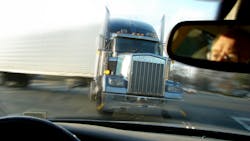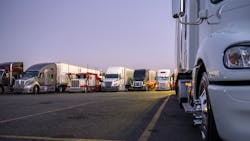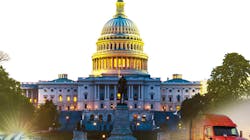As we close out the year, the editors of FleetOwner have picked these 10 stories as the very best of our work in 2021 from our magazine and website. They represent the top examples of our lofty reporting, writing, editing, and presentation standards—which is our commitment to you, our industry and readers.
When putting together this list we discovered that our top 10 stories mostly have a common thread: technology.
ADAS remains a focus as the emerging cluster of technologies represent the future of safety for fleets and independent operators.
In fact, for an industry that was regarded as behind in technology just 10 years ago, advancement lately has been rapid—not only in onboard safety systems but in trailer telematics and even, in this pandemic era, remote communications for staff and drivers and cybersecurity. Autonomous trucking also continues to advance, and tech is even helping to prevent nuclear verdicts and is easing the search on the road for safe truck parking, which still is in short supply.
We also wrote a lot this year about regulation, an ever-present concern, as the tentacles of oversight touch most of trucking's day-to-day operations.
But without further hesitation, we present our best stories—and wish our industry a healthy and prosperous new year!
10. Trucking's ADAS technologies still have many barriers to overcome
Advanced driver assistance systems—think automatic emergency braking, adaptive cruise control, active lane-keeping functions, and lane-departure warning systems—were invented to reduce human errors and ultimately decrease the number of accidents on the road. But before these systems find their footing and are widely accepted among commercial truck fleets and drivers, certain misconceptions and driver frustrations must be resolved.
The Virginia Tech Transportation Institute has been investigating and researching the various technical and market barriers that are limiting fleets’ adoption of ADAS technologies today. Technical barriers, according to Matt Camden, senior research associate for VTTI’s Center for Truck and Bus Safety, typically center around the engineering and technical aspects of a technology’s ability to function as intended—whereas market barriers tend to focus on the factors that impact the acceptance of the technology.
Check out the full story here.
9. Smart trailers are making trucking more efficient
Everything is getting smart these days: From smart kitchen appliances to smart doorbells and watches. Trucks and trailers are getting smarter, too. After spending most of the 20th century slowly implementing new technology, the trucking industry is leaning into the smarter, technology-rich 21st century. Trucking’s smarter future is safer, more efficient, and profitable because of its potential to make fleets smarter.
“A smart trailer is a trailer that really talks to you,” Nada Jiddou, EVP of Clarience Technologies and general manager of Road Ready, told FleetOwner. “It is a trailer that knows its current state. It knows its systems and its operation, health, and status at any given point in time. It is also able to communicate that to the fleet—or the operator—comprehensively with a complete data set.”
Check out the full story here.
8. Fleets pivot to remote communications strategies
Since the start of the pandemic, many commercial fleets have shifted toward trends that have been commonplace outside of trucking for years. Whether it was a transition to more online orientation for new drivers, the proliferation of Zoom virtual meetings and other online platforms to stay connected with employees and industry peers, or the reliance on podcasts and social media platforms to keep employees informed, fleets have turned to more creative ways to stay connected in this new socially distant world.
For years, Kansas City, Missouri-based American Central Transport (ACT), a dry van carrier operating in the central Midwest and Southeast, had a weekly hotline that drivers could call in and listen to company updates. The problem with that hotline was every week a new session would be recorded over the previous week’s session, so if drivers didn’t have a chance to listen in one week, it would be too late the next. Since March 2020, however, COVID has been a driving force for some of the changes ACT has made when it comes to communicating with its 300 drivers.
Check out the full story here.
7. COVID-19 left companies that didn’t upgrade cybersecurity more vulnerable
Cybersecurity attacks cost the transportation industry nearly $4 million as cybercriminals preyed on businesses across the nation adjusting to remote work during the pandemic. Cybersecurity plans created before COVID-19 changed the world but might not be up to the challenges of 2021 and beyond, according to Joe Russo, Isaac Instruments IT director.
"It's a matter of when—not if—you have a security incident," Russo said during the transportation technology company's virtual user conference last week. "Security threats are not going away. The costs are significant."
Check out the full story here.
6. Autonomous truck testing heats up under the Texas sun
If you’ve traveled on a major highway in Texas recently, there’s a good chance you’ve shared the road with a self-driving tractor-trailer. Artificial intelligence is putting the virtual pedal to the metal in long-haul trucking this year. Nowhere else in the U.S. is that more evident than in the Lone Star State.
More and more trucking technology companies are moving from conceptual to actual self-driving tractors as the industry gets closer to taking the human out of the cab to move freight in the U.S. by the middle of the decade.
Another player in the advanced truck technology space, Aurora, said it is working 24/7 to make it possible to transport freight by truck from Dallas to Los Angeles in less than 24 hours.
Check out the full story here.
5. Using technology to prevent nuclear verdicts
In the unfortunate event of a truck-related fatality, it’s common for the driver steering the 18-wheeler, and company he or she works for, to get the blame. It’s no help to the trucking community that the photographs of the scene play up the horror element: a chunk of highway surrounded by yellow police tape and shaded red by ambulance lights, where the passenger cars are mangled messes of steel and the semi stands intact.
That trucker must have fallen asleep, been on their phone or just not be very good at their job, many seeing such images reason. While those are all possible reasons for a crash, of course, the data tells a different story.
A 2002 American Automobile Association (AAA) study using 1995-1998 data assigned driver-related factors on the part of passenger car drivers 80% of the time in fatal car-truck crashes versus 27% for commercial truck drivers.
Check out the full story here.
4. Understanding Gen Z could be key to unlocking staff shortages
Don’t confuse Generation Z with millennials. The younger generation, which is just entering the workforce, has different goals and ideas of what makes for promising careers. Understanding the next generation and what they want in a company can help businesses get the edge on the competition this decade.
As the baby boomer generation continues to retire, fleets and other transportation companies are fighting over a smaller hiring pool of workers to fill drivers’ seats, maintenance bays, and logistics terminals. While a lot of attention in recent years was on recruiting and retaining millennials—workers born during the early 1980s and mid-1990s—companies need to take a different approach to attract Gen Z, the most diverse generation in the U.S.
Check out the full story here.
3. FleetOwner's top trucking industry influencers
In the 21st century, the term "influencer" can have a variety of meanings. An influencer could be a lifestyle blogger, a do-it-yourself contractor, a celebrity touting a specific brand or product—the list goes on. Though the typical social media influencer has built a reputation for their knowledge and expertise on a specific topic, they also are paid to encourage their followers to buy the products they promote.
But in commercial trucking, "influencer" has an entirely different meaning. And the people and organizations highlighted here are not your typical social media influencers.
It takes a certain type of person to push forward change and earn the title of influencer in trucking. According to Michael Roeth, one of this year's FleetOwner top industry influencers, any person in a basement can be called an expert, but influencers have to take action. They must be out there, influencing the change they want to make.
Check out the full story here.
2. Industry still behind in race for enough truck parking spaces
Trying to address the nationwide truck parking shortage is akin to the slowest runner in a race trying to catch up to the fastest. Finding adequate parking is a problem that continues to vex the trucking industry in much the same way.
Efforts at solutions to the shortage have been compounded by additional headwinds such as the ongoing COVID-19 pandemic, a shortfall of drivers that has ballooned to 80,000, the current supply chain crisis clogging ports and freight lanes, and infrastructure in the U.S. that is decaying to the point where operations are profoundly affected.
Check out the full story here.
1. Democrats have a small window to reshape trucking
One of the most significant trucking regulatory imprints of the Trump administration was the revamped hours-of-service (HOS) rules that redefined short hauls, break requirements, sleeper-berth provisions, and broadened the adverse driving conditions exceptions. Like Donald Trump, who came to Washington, D.C. with his party in control of Congress, Joe Biden and the Democrats have slim majorities in Congress that could push through a cascade of regulations that affect the trucking, transportation, and freight industries.
With those small Democratic majorities in the House and Senate, the party’s fragile grip on D.C. might not last for long. It’s been nearly 20 years since a president’s party retained control of Congress after his first midterm election. In the 117th U.S. Congress, the House’s Democratic caucus has a 10-member advantage (with three vacancies as of March 1); the Senate chamber’s two caucuses are evenly divided with Vice President Kamala Harris breaking the 50-50 tie for the Democrats.
Check out the full story here.
About the Author
FleetOwner Staff
Our Editorial Team
Kevin Jones, Editorial Director, Commercial Vehicle Group
Josh Fisher, Editor-in-Chief
Jade Brasher, Senior Editor
Jeremy Wolfe, Editor
Jenna Hume, Digital Editor
Eric Van Egeren, Art Director

